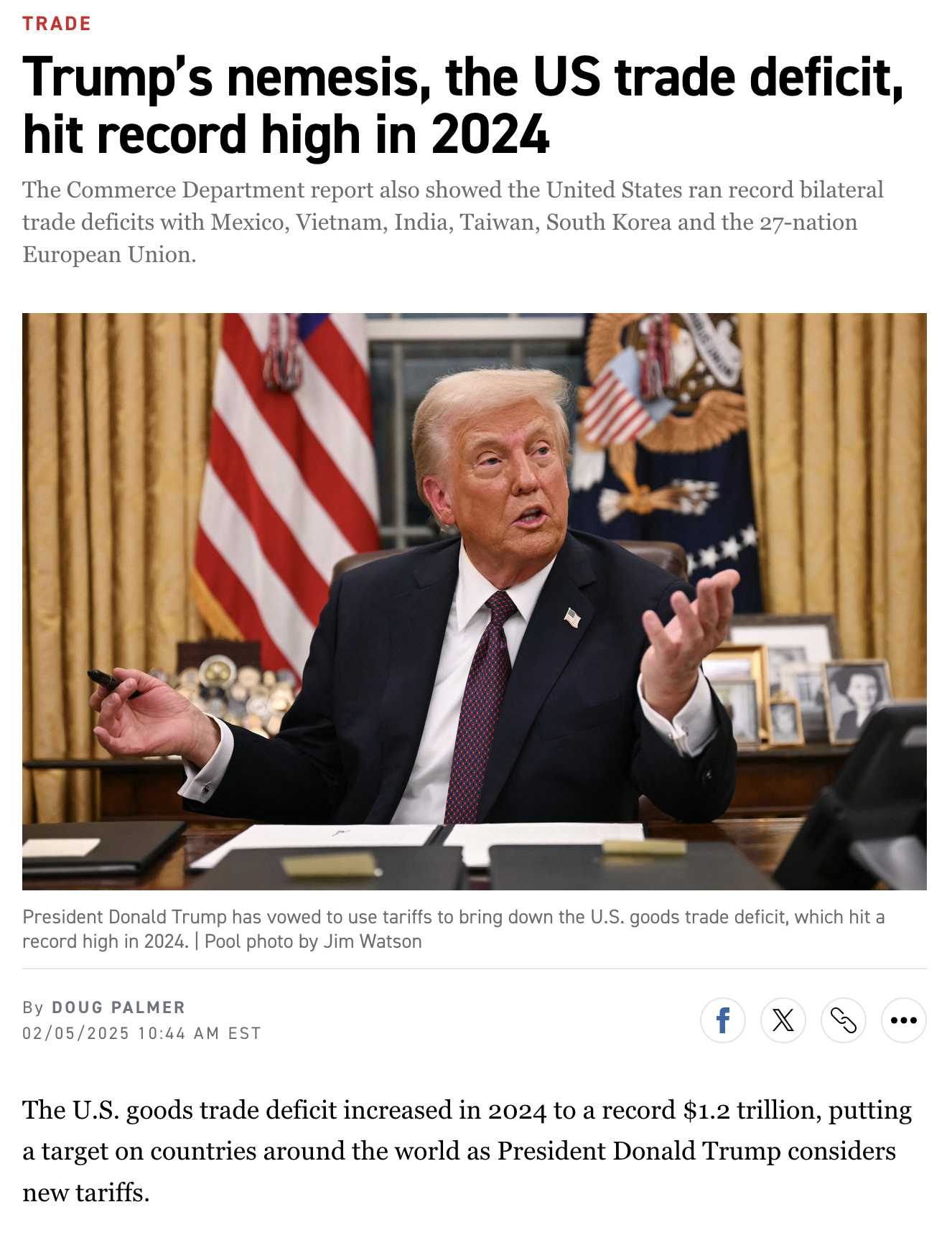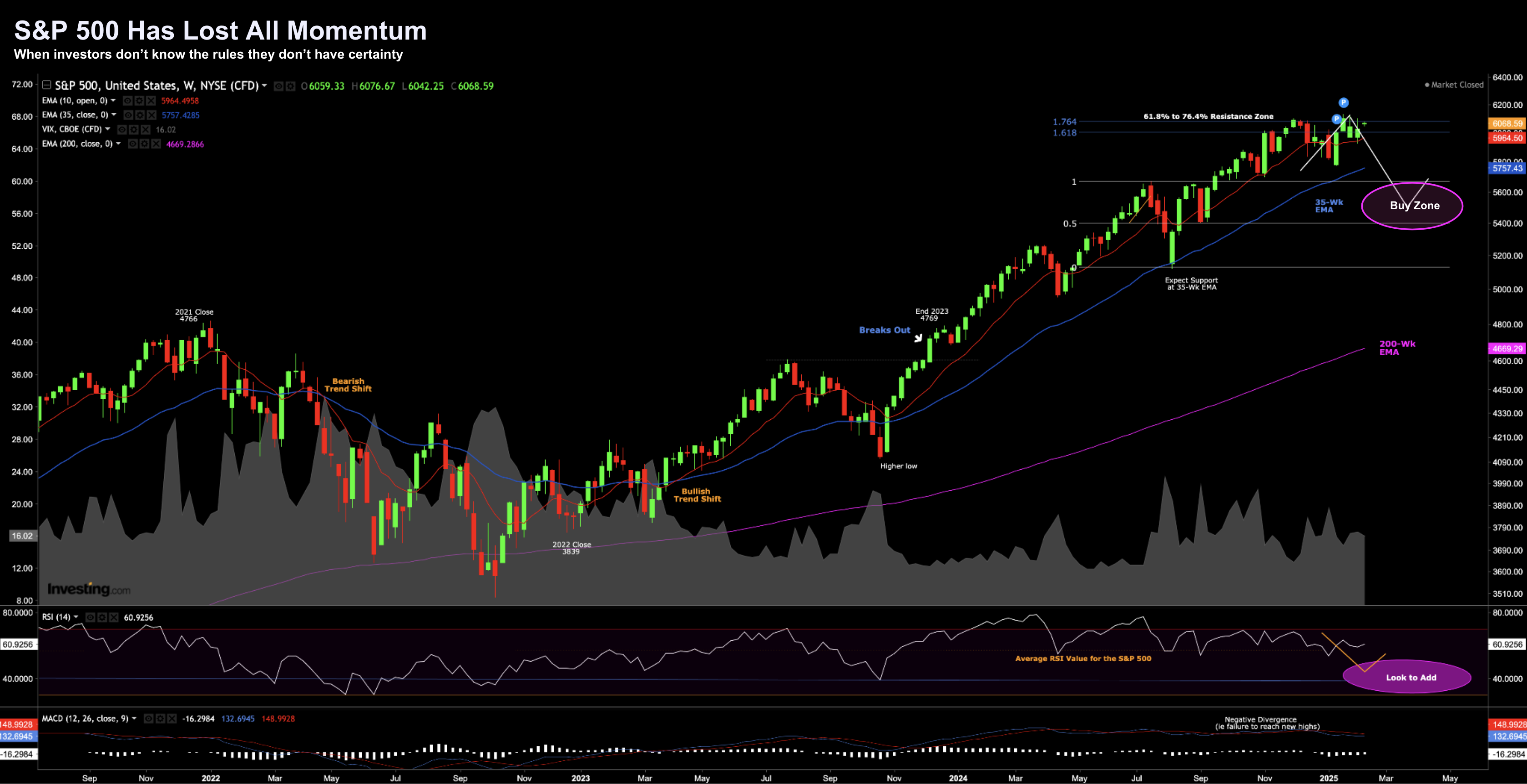Words: 692; Time: 4 Minutes
- Uncertainty comes from not knowing the rules
- China’s symbolic tariff tit-for-tat
- Three signs the market is starting to hedge its bets
As an investor – it’s very important to know the rules.
For example, if the rules are constantly influx – it leads to uncertainty.
With heightened uncertainty – you pull back.
That’s what faces investors.
For example, consider the following:
- Direction of monetary policy (e.g., as Powell raised concerns);
- A torrent of policy shifts from the White House; and
- Major disruption with artificial intelligence – as investors question return on capital invested.
Such growing uncertainty makes it harder to commit to stocks with conviction.
And we’re seeing it with the price action:
February 11 2025
16 weeks of basically no gains.
From a technical lens – two things I’ve continued to point out:
- Possible overhead resistance 61.8% to 76.4% outside the pullback from August (6100 zone); and
- Failing momentum with both the weekly MACD and RSI don’t confirm the new highs (lower two windows)
My best guess (and it’s only a guess) is we see the S&P 500 test the zone of ~5600 in the first half of this year.
However, the timing of knowing when the pull-back will occur is near impossible to do.
If I get it right – it’s only luck.
That said, whether a pull back of 10% to 15% happens in first or second half of 2025 – it doesn’t matter – you should be ready to capitalize.
Let’s explore what’s giving investor’s anxiety.
China’s Symbolic Tit-for-Tat
China’s retaliatory tariffs against the U.S. began on Monday with a muted market reaction.
And I think that makes sense….
Beijing’s response to Trump is more symbolic rather than a serious economic blow.
However Xi won’t be intimidated.
We also saw Trump announce a fresh 25% tariff on steel and aluminum imports from all countries, not just China.
For example, if you consider Australia, that’s roughly around $500M of annual exports (about 4% of all Australian-based US exports).
It’s irrelevant whether Australia imports more US goods than they export (which they do by a long margin) – aluminium and steel tariffs will go into effect.
Trump’s announcement, made before the tariffs take effect on March 12, included a promise of reciprocity — meaning that any country imposing tariffs on U.S. goods would face equal retaliatory duties.
Consider the following:
- India and Brazil impose an average tariff of ~11% to 13% on US goods;
- China is ~10% on US goods;
- Mexico ~7% on US goods; and
- South Africa ~9% on US goods.
Compare that with the US – the average tariff (across all goods) applied is only ~3%.
That’s quite low given the above.
Therefore, if Trump is keen on reciprocity, some of these countries are in for a rude awakening.
The key question is whether markets should treat the reciprocity announcement as empty posturing or anticipate actual consequences?
That’s the uncertainty.
While China’s leader, Xi Jinping, wants to avoid a trade conflict that could jeopardize China’s economic recovery, Trump’s tariffs are aimed at eliminating trade deficits, particularly with China.
For example, according to Marketwatch.com, in 2024:
- The US experienced a trade deficit with China totaling ~$295B (the largest of any country)
- Mexico has a trade deficit with the US of ~$172B; and
- Vietnam ~$123B
Overall, the U.S. goods trade deficit reached a record $1.2 trillion in 2024, a 14% increase from the previous year.

But my view on these “tariff wars” will fall away.
A deal will be found.
I continue to believe this is Trump posturing to get the US a ‘better deal’ for access to US markets.
However, this is a delicate dance.
I say that because the U.S. and China are so economically integrated that if the tariffs were pro-longed – it would harm both countries.
See this post “Zero Sum Game” as to why I’m not a fan of tariffs.
Free (and fairer) trade is the goal.
Markets Start to Hedge
Despite Trump’s strong rhetoric, the tariffs sound a lot more like brinkmanship than actual economic impact.
For example, Bloomberg Economics suggests that the U.S. would have to reduce tariffs on Chinese goods to match China’s lower duties.
If accurate, this means that any immediate threat to China might not be as severe as it seems.
However, the U.S. could still increase tariffs on Chinese goods, though it’s uncertain if they will reach the “60% level” Trump once threatened.
But we cannot know if Trump will not follow through?
That’s not a bet you can take.
For example, he may have to enforce tariffs for a period – if nothing else to demonstrate he’s not just bluster.
That will cause angst in markets (but also opportunity)
And to that end, it’s why markets remain uncertain.
Three things I’ve observed over the past few weeks:
- Gold hitting record highs (a classic hedge);
- A general rise in the price of most commodities; and finally
- Investors hedging their bets towards more domestically oriented stocks.
And whilst the current “trade conflict” (if that’s the right word) may not cause immediate major disruption — investors cannot ignore the threat.
However, if we see the S&P 500 trade down to the zone I expect (e.g., around 5600) – it will be time to sharpen your pencils.
Putting it All Together
I continue to watch the market lose momentum.
For example, if I only look at the Mag 7 post earnings – only one of the seven companies rose after earnings – Meta.
Why?
They were able to demonstrate a clear connection between the (very large) capex investments in GenAI and advertising returns.
More broadly, the market is showing a sense of caution.
Not only is it fundamentally very expensive – the unknowns regarding:
- monetary and fiscal policy;
- trade wars;
- bond yields; and ongoing
- dollar strength…
Stay patient. And be sure to keep some powder dry.

